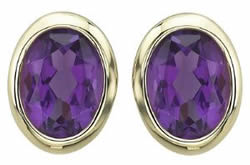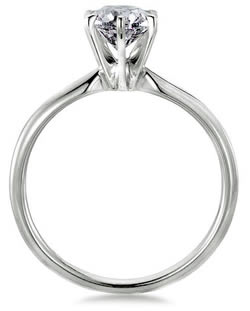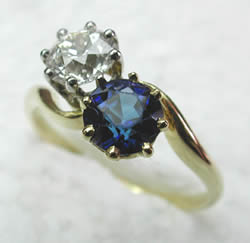Your Details
Your Details
|
Reviewed By Andreas Zabczyk
Prong Vs. Bezel Settings Bezel-Set Amethysts
The two most common ways of mounting a large single gemstone are the prong (also called claw) setting and the bezel setting. These two popular settings are used in earrings and pendants as well as rings. In a prong setting there are typically three or more pieces of metal raised above the base of the setting, which bend slightly over the stone to hold it in place. Usually the prongs are notched so that the girdle of the gemstone sits firmly in the prong. In a bezel setting a piece of metal partially or completely surrounds the stone to hold it in place.  Classic Tiffany 4-Prong Setting
Both types of setting have their advantages and disadvantages. The main advantage of the bezel setting is that it is very protective of the gemstone, and this is particularly important with some stones that have become popular due to their lesser hardness. Gems such as opal, sphene, chrome diopside, turquoise, apatite and fluorite have a hardness score of less than 7 on the Mohs scale, meaning they can be scratched fairly easily. Bezel settings help to protect these softer stones, particularly if they are set in rings. Another advantage of the bezel setting is that a well-designed precious metal bezel can be extremely attractive. The main disadvantage of bezel settings is that they are typically more expensive. This type of setting requires more metal, and the setting usually has to be custom-made to properly fit the gemstone. A bezel also covers more of the gemstone. This is not so much of an issue with opaque stones like most cabochons, but it may affect the amount of light that reaches a transparent stone. Some designs address this issue with bezels that that don't completely surround the stone. The height of the bezel is also an important factor; a lower bezel will expose more of the stone.  8-Prong Sapphire Diamond Setting
Prong settings offer ideal visibility for the gemstone, presenting both benefits and drawbacks. On one hand, prong settings allow more light to illuminate the stone, creating the illusion of a larger gem by elevating it from the band, as seen in the iconic Tiffany setting. However, this design also leaves the gem vulnerable to impacts and collisions. Regular inspection of prong settings is essential to verify the stability of each claw and prevent any potential loosening or breakage. A damaged or missing claw could result in the unfortunate loss of a precious gemstone. Though prongs are often unobtrusive, different designs can enhance the setting. Prongs come in many different shapes, and there are special ones to hold the sharp points of a marquise or pear-shaped gem. The most common prong settings use 4, 6 or even 8 prongs. The greater the number of prongs, the more secure the setting. The quality of the setting is also extremely important. A well-constructed prong setting will last for many years. |
